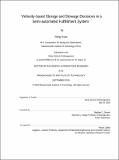| dc.contributor.advisor | Stephen C. Graves. | en_US |
| dc.contributor.author | Yuan, Rong, Ph. D. Massachusetts Institute of Technology | en_US |
| dc.contributor.other | Massachusetts Institute of Technology. Operations Research Center. | en_US |
| dc.date.accessioned | 2017-01-30T18:50:24Z | |
| dc.date.available | 2017-01-30T18:50:24Z | |
| dc.date.copyright | 2016 | en_US |
| dc.date.issued | 2016 | en_US |
| dc.identifier.uri | http://hdl.handle.net/1721.1/106682 | |
| dc.description | Thesis: Ph. D., Massachusetts Institute of Technology, Sloan School of Management, Operations Research Center, 2016. | en_US |
| dc.description | This electronic version was submitted by the student author. The certified thesis is available in the Institute Archives and Special Collections. | en_US |
| dc.description | Cataloged from student-submitted PDF version of thesis. | en_US |
| dc.description | Includes bibliographical references (pages 153-156). | en_US |
| dc.description.abstract | The supply chain management for an online retailing business is centered around the operations of its fulfillment centers. A fulfillment center receives and holds inventory from vendors, and then uses this inventory to fill customer orders. Our research focuses on a new operating architecture of an order fulfillment system, enabled by new technology. We refer to it as the Semi-automated Fulfillment System. Different from the person-to-goods model in traditional warehouses, the semi-automated fulfillment system adopts a goods-to-person model for stowing and picking items from a storage field. In a semi-automated fulfillment system the inventory is stored on mobile storage pods; those mobile pods are then carried by robotic drives to static stations at which the operators conduct pick or stow operations. In the first chapter, we describe and identify three key operational decisions in the semiautomated fulfillment system, namely from which pods to pick the inventory needed (picking decision), where to return the pod to the storage field upon the completion of a pick or stow operation (storage decision), and to which pods to replenish the received inventory (stowage decision). We present a high-level capacity planning model for determining the number of robotic drives needed to achieve a given throughput level. This model highlights how the operational efficiency in this system depends on two key parameters, namely the travel time for an entire drive trip and the number of unit picks or stows per pod trip. In the second chapter, we focus on the storage decisions. The storage decision is to decide to which storage location to return a pod upon the completion of a pick or stow operation. We extend the academic results on the benefits of adopting velocity-based and class-based storage policies to the context of the semi-automated fulfillment system. We associate with each storage pod a velocity measure that represents an expectation of the number of picks from that pod in the near future. We then show that by assigning the high velocity pods to the most desirable storage locations, we can significantly reduce the drive travel time, compared to the random storage policy that returns the pod to a randomly-chosen storage location. We show that class-based storage policies with two or three classes, can achieve most of the benefits from the idealized velocity-based policy. Furthermore, we characterize how the performance of the velocity-based and class-based storage policies depend on the velocity variability across the storage pods; in particular we model how the benefits from velocity-based storage policies increase with increased variation in the pod velocities. In the third chapter, we build a discrete-time simulator to validate the theoretical models in the second chapter with real industry data. We observe a 6% to 11% reduction in the travel distance with 2-class or 3-class system, depending on the parameter settings. From a sensitivity analysis we establish the robustness of the class-based storage policies as they continue to perform well under a broad range of warehouse settings including different zoning strategies, resource utilization levels and space utilization levels. In the fourth chapter, we examine two stowage decisions, one at the zone level and the other at the pod level. The zone-level decision is to decide how to allocate the received inventory to multiple storage zones. The objective is to assure that the resulting picking workload for each zone is within its capacity. We show by simulation that a chaining-based allocation can be effective to balance the picking workload across different storage zones. The pod-level stowage decision is to decide on which pods to stow the inventory. We formulate a mixedinteger program (MIP) to find the optimal stowage profile that maximizes the number of unit picks per pod trip. We solve the MIP for a set of test cases to gain insight into the structure of optimal stowage policy. Motivated by these insights, we further propose a class-based stowage process that induces variability across the pod velocities. | en_US |
| dc.description.statementofresponsibility | by Rong Yuan. | en_US |
| dc.format.extent | 156 pages | en_US |
| dc.language.iso | eng | en_US |
| dc.publisher | Massachusetts Institute of Technology | en_US |
| dc.rights | MIT theses are protected by copyright. They may be viewed, downloaded, or printed from this source but further reproduction or distribution in any format is prohibited without written permission. | en_US |
| dc.rights.uri | http://dspace.mit.edu/handle/1721.1/7582 | en_US |
| dc.subject | Operations Research Center. | en_US |
| dc.title | Velocity-based storage and stowage decisions in a semi-automated fulfillment system | en_US |
| dc.type | Thesis | en_US |
| dc.description.degree | Ph. D. | en_US |
| dc.contributor.department | Massachusetts Institute of Technology. Operations Research Center | |
| dc.contributor.department | Sloan School of Management | |
| dc.identifier.oclc | 969768684 | en_US |
